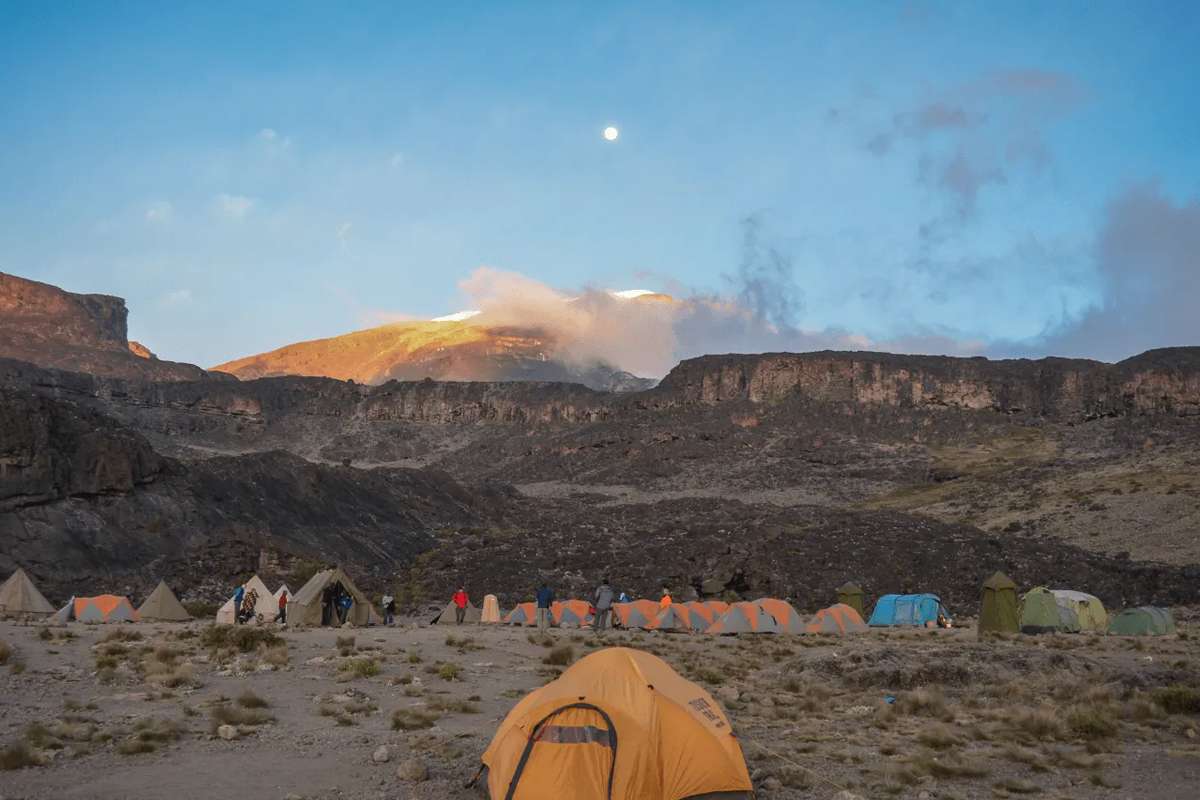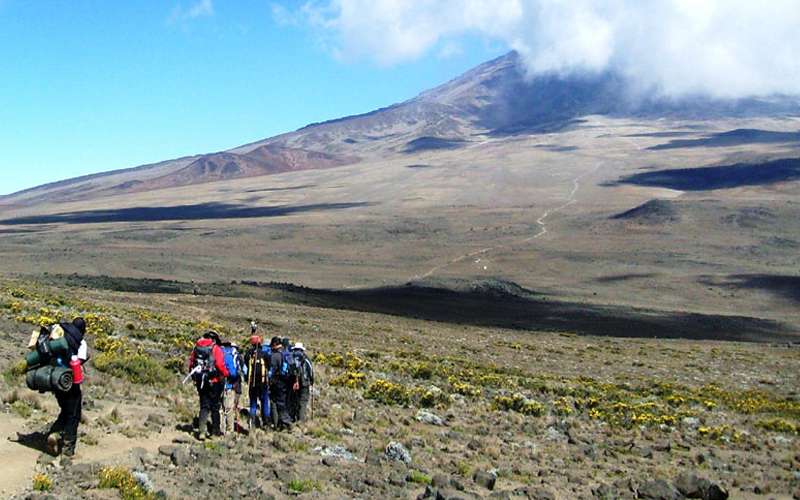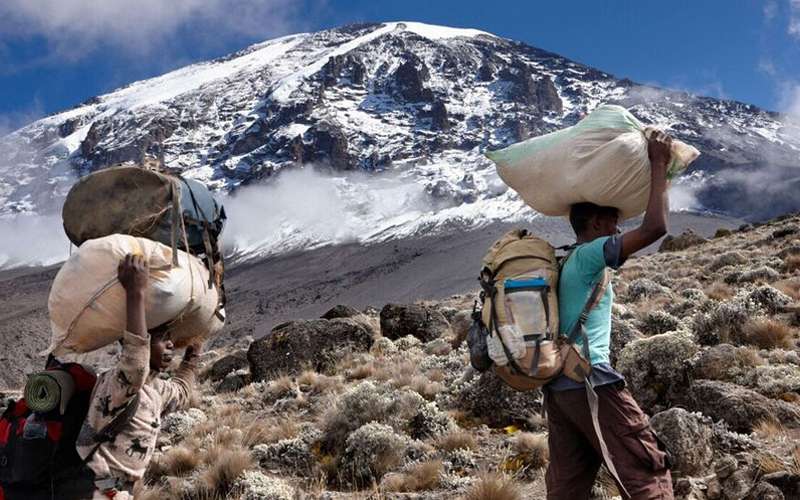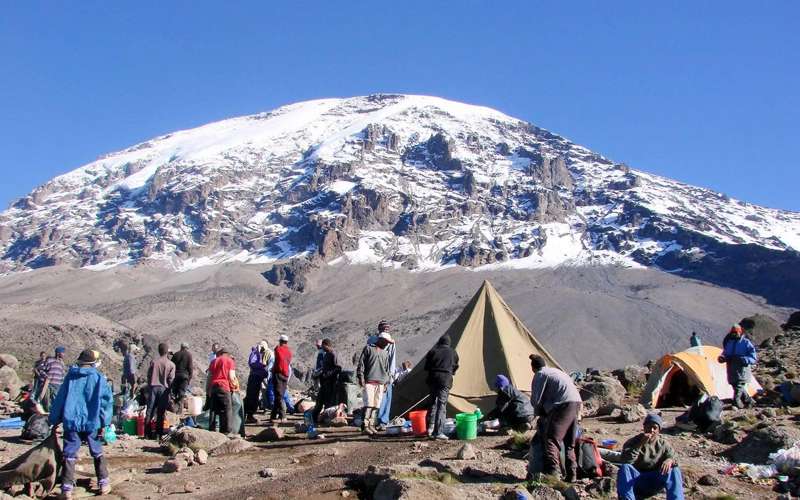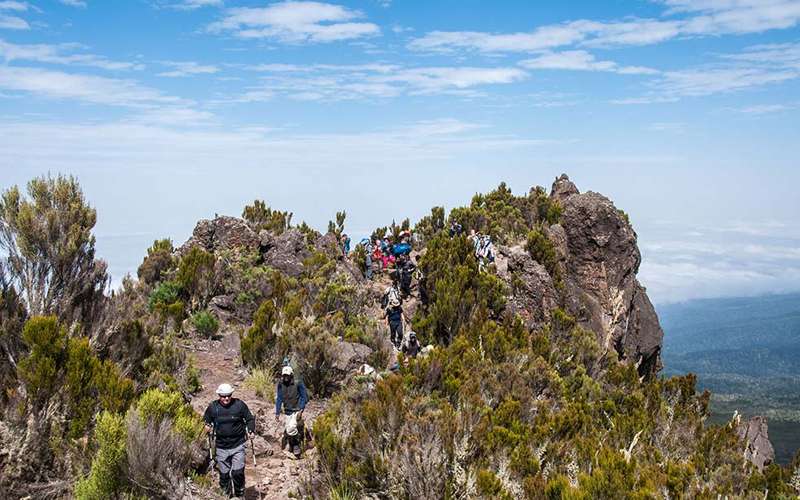Rising majestically above the African savannah, Mount Kilimanjaro stands as the tallest peak on the continent, beckoning adventurers from around the world. The Northern Circuit Route offers a unique and immersive journey to the summit, characterized by its unparalleled scenery, diverse ecosystems, and sense of solitude.
Why Choose the Northern Circuit Route?
- Unique Features: The Northern Circuit Route is renowned for its extensive duration and gradual ascent, allowing for superior acclimatization and increased chances of summit success. This route offers panoramic views of the surrounding landscape, including the rugged slopes of Kilimanjaro and the vast plains of Tanzania below.
- Scenery and Solitude: Traversing through lush rainforests, alpine meadows, and lunar landscapes, the Northern Circuit Route showcases the full spectrum of Kilimanjaro’s natural beauty. Unlike other popular routes, the Northern Circuit offers a quieter and more secluded trekking experience, allowing climbers to connect with nature and find inner peace amidst the wilderness.
Preparation for the Climb
- Physical Fitness and Training: Preparing for the Northern Circuit Route requires a good level of physical fitness and endurance. Engaging in regular cardiovascular exercises, strength training, and hiking with a weighted backpack will help condition your body for the demands of the trek.
- Necessary Gear and Equipment
Packing the right gear is essential for a successful climb. Key items include:
- Clothing: Layered clothing to adapt to changing temperatures, including thermal base layers, insulating mid-layers, and waterproof outer layers.
- Footwear: Sturdy, comfortable hiking boots with good ankle support and quality trekking socks.
- Accessories: Hats, gloves, sunglasses, and trekking poles.
- Backpack: A daypack for personal items and a larger pack for porters to carry.
Detailed Itinerary of the Northern Circuit Route
- Day-by-Day Breakdown
Day 1: Londorossi Gate to Mti Mkubwa Camp
- Elevation: From 2,360m to 2,820m
- Terrain: Rainforest
- Distance: 7 km (4.3 miles)
Day 2: Mti Mkubwa Camp to Shira 1 Camp
- Elevation: From 2,820m to 3,610m
- Terrain: Moorland
- Distance: 8 km (5 miles)
Day 3: Shira 1 Camp to Moir Hut
- Elevation: From 3,610m to 4,200m
- Terrain: Alpine Desert
- Distance: 11 km (6.8 miles)
Day 4: Moir Hut to Pofu Camp
- Elevation: From 4,200m to 4,033m
- Terrain: Alpine Desert
- Distance: 6 km (3.7 miles)
Day 5: Pofu Camp to Third Cave
- Elevation: From 4,033m to 3,800m
- Terrain: Alpine Desert
- Distance: 7 km (4.3 miles)
Day 6: Third Cave to School Hut
- Elevation: From 3,800m to 4,800m
- Terrain: Alpine Desert
- Distance: 8 km (5 miles)
Day 7: Summit Day – School Hut to Uhuru Peak to Mweka Camp
- Elevation: From 4,800m to 5,895m (summit), then down to 3,100m
- Terrain: Arctic Summit and Rainforest
- Distance: 18 km (11.2 miles)
Day 8: Descent from Uhuru Peak to Mweka Camp
- Elevation: From 5,895m (summit), then down to 3,100m
- Terrain: Arctic Summit and Rainforest
- Distance: 18 km (11.2 miles)
After an exhilarating and awe-inspiring summit of Uhuru Peak, the highest point on Mount Kilimanjaro, climbers begin their descent back to lower elevations. The descent from the summit to Mweka Camp is a crucial part of the journey, as it allows trekkers to gradually adjust to the decreasing altitude and relieve any lingering symptoms of altitude sickness.
- Key Highlights and Landmarks
- Londorossi Gate: The starting point of the trek, where climbers register and begin their journey.
- Shira Plateau: A vast plateau offering panoramic views of Kilimanjaro’s western slopes and the surrounding landscape.
- Moir Hut: Positioned at the edge of the northern circuit, providing stunning views of the Northern Icefields and the Kenyan plains.
- School Hut: The final base camp before the summit push, offering basic amenities and a place to rest before the ascent.
Acclimatization and Altitude Sickness
- Importance of Acclimatization: Proper acclimatization is crucial to prevent altitude sickness and increase the likelihood of summit success. The gradual ascent of the Northern Circuit Route allows for better adaptation to high altitudes, reducing the risk of altitude-related issues.
- Tips for Preventing Altitude Sickness
- Hydration: Drink plenty of fluids to stay hydrated.
- Pacing: Maintain a slow and steady pace to allow your body to adjust.
- Diet: Eat light, high-energy meals to maintain your strength.
- Medication: Consider taking altitude sickness medication like Diamox, as recommended by a healthcare professional.
Guides and Porters
- Role of Guides and Porters: Experienced guides play a vital role in navigating the Northern Circuit Route, providing valuable knowledge of the terrain, weather conditions, and safety protocols. Porters, on the other hand, carry equipment, set up camps, and ensure the trek runs smoothly. Their hard work allows climbers to focus on the journey and enjoy the experience without the burden of heavy loads.
- Tipping and Etiquette: Tipping is customary in Tanzania and serves as a token of appreciation for the dedication and hard work of guides and porters. While tipping amounts may vary, it’s important to consider the effort put forth by the support team throughout the trek. Tipping is usually done at the end of the climb, directly to each guide and porter.
Campsites Along the Northern Circuit Route
- Facilities and Amenities: Campsites along the Northern Circuit Route provide essential facilities such as tents, dining areas, and basic sanitation facilities. While amenities may be limited, the natural beauty and tranquility of the surroundings more than compensate for any rustic accommodations.
- Description of Each Campsite
- Mti Mkubwa Camp: Situated in the lush rainforest, Mti Mkubwa Camp offers a serene setting for the first night of the trek.
- Shira 1 Camp: Located on the Shira Plateau, Shira 1 Camp provides panoramic views of the surrounding landscape and a sense of tranquility.
- Moir Hut: Positioned on the northern slopes of Kilimanjaro, Moir Hut offers stunning views of the Northern Icefields and a peaceful atmosphere.
- School Hut: Situated at the base of the final ascent to Uhuru Peak, School Hut provides basic amenities and a place to rest before the summit push.
Wildlife and Flora on the Northern Circuit Route
- Unique Species and Vegetation: The Northern Circuit Route showcases a rich diversity of flora and fauna, ranging from lush rainforests to alpine deserts. Trekkers may encounter various species of birds, monkeys, and unique plant life throughout the journey. Conservation efforts aim to preserve the natural habitats and ecosystems of Kilimanjaro for future generations to enjoy.
- Conservation Efforts: Efforts to protect the natural environment of Kilimanjaro are ongoing, with organizations and local communities working together to promote sustainable tourism practices. Climbers are encouraged to minimize their environmental impact by adhering to Leave No Trace principles and respecting wildlife and vegetation.
Cultural Experiences
- Interactions with Local Communities: Trekkers on the Northern Circuit Route may have the opportunity to interact with the local Chagga and Maasai communities, gaining insights into their traditional lifestyles, customs, and cultural practices. These interactions enrich the trekking experience and foster mutual understanding and appreciation.
- Cultural Significance of Kilimanjaro: Kilimanjaro holds deep cultural significance for the indigenous communities of Tanzania, serving as a sacred site and a symbol of national pride. Local folklore and traditions often revolve around the majestic mountain, reflecting its importance in the cultural identity of the region.
Safety and Challenges
- Common Challenges Climbers Face: Climbers on the Northern Circuit Route may encounter challenges such as altitude sickness, extreme weather conditions, and physical exhaustion. It’s essential to be prepared mentally and physically for the demands of the trek and to listen to the guidance of experienced guides.
- Safety Precautions and Emergency Procedures: Guides are trained in first aid and emergency procedures, ensuring the safety and well-being of climbers throughout the journey. It’s crucial to follow their instructions, stay hydrated, and report any symptoms of illness or discomfort promptly. Additionally, carrying essential medications and emergency supplies is recommended.
Best Time to Trek
- Seasonal Weather Conditions: The best time to trek the Northern Circuit Route is during the dry seasons, from January to mid-March and June to October. These periods offer favorable weather conditions, with clear skies and mild temperatures, enhancing the trekking experience and increasing the chances of summit success.
- Recommended Months for Climbing: The most recommended months for climbing the Northern Circuit Route are January, February, and September, as they coincide with the dry seasons and offer optimal weather conditions for trekking. Climbers can expect fewer crowds and stunning views of the surrounding landscape during these months.
Sustainable Trekking Practices
- Leave No Trace Principles: Climbers should adhere to Leave No Trace principles to minimize their environmental impact and preserve the natural beauty of Kilimanjaro for future generations. This includes packing out all trash, avoiding single-use plastics, and respecting wildlife and vegetation.
- Supporting Local Economies: By hiring local guides and porters, purchasing locally-made products, and staying in community-run accommodations, climbers can support the local economy and contribute to sustainable tourism practices. This fosters positive relationships between travelers and local communities and promotes cultural exchange and understanding.
The Northern Circuit Route offers an immersive and unforgettable journey to the summit of Mount Kilimanjaro. With its breathtaking scenery, diverse ecosystems, and sense of solitude, this route provides a truly unparalleled trekking experience for adventurers seeking to conquer Africa’s highest peak. By embracing sustainable practices, respecting local cultures, and prioritizing safety, climbers can embark on a rewarding journey to the summit and create memories that will last a lifetime.
FAQs
How long does it take to climb the Northern Circuit Route?
The Northern Circuit Route typically takes 9 to 10 days to complete, including time for acclimatization and summit attempts.
What is the success rate for climbers on the Northern Circuit Route?
The success rate for climbers on the Northern Circuit Route is approximately 90%, due to its gradual ascent and favorable weather conditions.
Circuit Route compared to other routes?
The Northern Circuit Route is considered moderately difficult, offering a good balance of challenge and acclimatization. While it is longer than some other routes, its gradual ascent profile and extended duration contribute to a higher success rate for climbers.
What should I pack for the Northern Circuit Route trek?
Essential items to pack for the Northern Circuit Route trek include:
- Clothing: Layered clothing suitable for varying temperatures, including thermal base layers, insulating mid-layers, and waterproof outer layers.
- Footwear: Sturdy hiking boots with good ankle support, quality trekking socks, and gaiters to keep out debris.
- Accessories: Hats, gloves, sunglasses, and a buff or scarf for protection against wind and sun.
- Equipment: Trekking poles, a comfortable backpack with rain cover, and a headlamp with extra batteries.
- Sleeping Gear: A warm sleeping bag suitable for sub-zero temperatures and a sleeping pad for insulation.
- Personal Items: Sunscreen, lip balm with SPF, personal hygiene products, and any necessary medications.
- Snacks and Hydration: High-energy snacks such as nuts, dried fruits, and energy bars, as well as a reusable water bottle or hydration bladder.
Can beginners successfully climb Kilimanjaro via the Northern Circuit Route?
While the Northern Circuit Route is longer and more challenging than some other routes, beginners with a reasonable level of fitness and proper preparation can complete the trek. Engaging in physical training, acclimatization hikes, and following the guidance of experienced guides are essential for a safe and enjoyable climb.
In conclusion, embarking on the Northern Circuit Route offers adventurers the opportunity to experience the awe-inspiring beauty of Mount Kilimanjaro while enjoying a less crowded and more immersive trekking experience. By preparing adequately, respecting the environment and local cultures, and prioritizing safety, climbers can embark on a journey of a lifetime to conquer Africa’s highest peak and create unforgettable memories along the way.
For an enriching Kilimanjaro trekking experience and cultural immersion in Tanzania, explore the following topics on our page:
– Kilimanjaro Packing List
– Top Mount Kilimanjaro FAQs
– Maasai Village Experience
Find detailed information and essential tips to ensure a successful climb and memorable cultural encounter.


